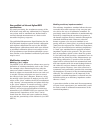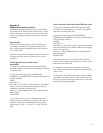
17
Note
Mathematical operations on measurements (and
displayed data) after calibration are not corrected
for dispersion.
Enter WAVEGUIDE into the standard definition
table for all four standards.
Standard labels
Labels are entered through the title menu and may
contain up to 10 characters. Standard Labels are
entered to facilitate menu driven calibration.
Labels that describe and differentiate each stan-
dard should be used. This is especially true for
multiple standards of the same type.
When sexed connector standards are labeled, male
(M) or female (F), the designation refers to the test
port connector sex—not the connector sex of the
standard. Further, it is recommended that the label
include information carried on the standard such
as the serial number of the particular standard to
avoid confusing multiple standards which are simi-
lar in appearance.
The labels for the four standards in the waveguide
example are; #1-PSHORT1, #2-PSHORT2, #3-PLOAD,
and #4-THRU.
Assign classes
In the previous section, define standards, the
characteristics of calibration standards were
derived. Class assignment organizes these stan-
dards for computation of the various error models
used in calibration. The Agilent 8510 requires a
fixed number of standard classes to solve for the n
terms used in the error models (n = 1, 3, or 12).
That is, the number of calibration error terms
required by the 8510 to characterize the measure-
ment system (1-Port, 2-Port, etc.) equals the num-
ber of classes utilized.
Standard Classes
A single Standard Class is a standard or group of
(up to 7) standards that comprise a single calibra-
tion step. The standards within a single class are
assigned to locations A through G as listed on the
Class Assignments table. It is important to note
that a class must be defined over the entire fre-
quency range that a calibration is made, even
though several separate standards may be required
to cover the full measurement frequency range. In
the measurement calibration process, the order of
standard measurement within a given class is not
important unless significant frequency overlap
exists among the standards used. When two stan-
dards have overlapping frequency bands, the last
standard to be measured will be used by the 8510.
The order of standard measurement between dif-
ferent classes is not restricted, although the 8510
requires that all standards that will be used within
a given class are measured before proceeding to
the next class. Standards are organized into speci-
fied classes which are defined by a Standards
Class Assignment table. See Table 2 for the class
assignments table for the waveguide calibration kit.


















